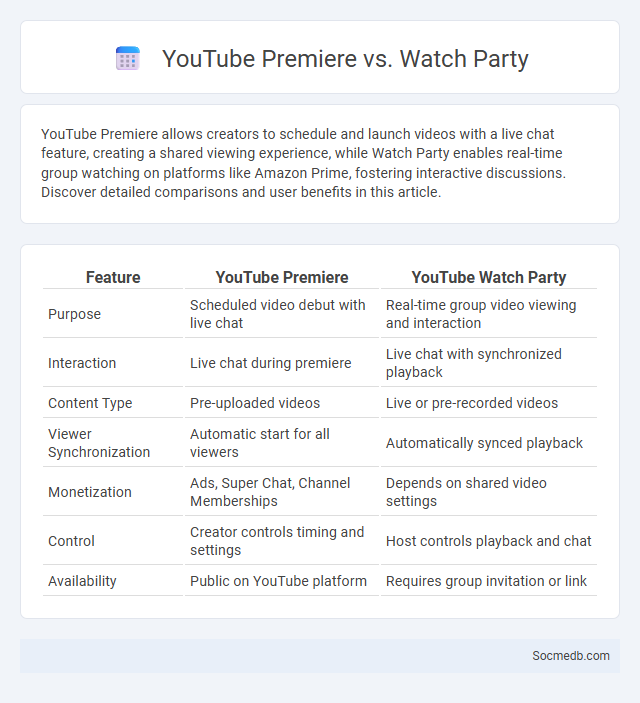
Photo illustration: YouTube Premiere vs Watch Party
YouTube Premiere allows creators to schedule and launch videos with a live chat feature, creating a shared viewing experience, while Watch Party enables real-time group watching on platforms like Amazon Prime, fostering interactive discussions. Discover detailed comparisons and user benefits in this article.
Table of Comparison
| Feature | YouTube Premiere | YouTube Watch Party |
|---|---|---|
| Purpose | Scheduled video debut with live chat | Real-time group video viewing and interaction |
| Interaction | Live chat during premiere | Live chat with synchronized playback |
| Content Type | Pre-uploaded videos | Live or pre-recorded videos |
| Viewer Synchronization | Automatic start for all viewers | Automatically synced playback |
| Monetization | Ads, Super Chat, Channel Memberships | Depends on shared video settings |
| Control | Creator controls timing and settings | Host controls playback and chat |
| Availability | Public on YouTube platform | Requires group invitation or link |
Introduction to YouTube Premiere, Watch Party, and Premiere
YouTube Premiere enables creators to schedule and debut new videos with a live chat, fostering real-time viewer interaction and anticipation. Watch Party features allow influencers and brands to stream pre-recorded content simultaneously with their audience, enhancing communal viewing experiences. Premieres combine video premieres and live streaming elements, maximizing engagement and viewer retention through countdowns and immediate feedback.
What is YouTube Premiere?
YouTube Premiere is a feature that allows creators to schedule and debut videos with a live chat experience, enhancing real-time viewer engagement. Your audience can watch the video together at the same time, interact through live chat, and build excitement before the content goes live. This tool is optimized to boost visibility and foster a community around your newest video releases.
Understanding Watch Party Features
Watch Party features on social media platforms enable you to stream and synchronize videos with friends and followers, creating an interactive viewing experience. These tools often include real-time chat, reactions, and the ability to invite multiple participants, enhancing engagement and community bonding. Understanding how to use Watch Party features maximizes your social media presence and fosters stronger connections through shared content.
Overview of Premiere (on Streaming Platforms)
Premiere on streaming platforms revolutionizes content consumption by offering immediate access to exclusive releases without traditional broadcast delays. This model enhances audience engagement through interactive features such as live chats, real-time reactions, and social media integrations. Streaming premieres leverage data analytics to tailor recommendations, maximizing viewer retention and expanding reach across diverse demographics.
Key Differences Between YouTube Premiere and Watch Party
YouTube Premiere allows creators to schedule and debut pre-recorded videos with a live chat feature enabling real-time audience interaction, while Watch Party is a feature for synchronously viewing live streams or videos with friends in a shared space. Premiere supports a global audience and monetization options like Super Chats and ads, whereas Watch Party emphasizes private group engagement without built-in monetization. The main difference lies in Premiere's focus on public launches and community building versus Watch Party's private, interactive viewing experience.
Audience Engagement: Which Is Better?
Audience engagement on social media thrives when content is tailored to your target demographic's interests and behaviors, utilizing interactive features like polls, stories, and live videos to foster participation. Platforms such as Instagram excel in visual engagement, while Twitter drives real-time conversations and LinkedIn targets professional networks. Understanding your audience's preferences and platform strengths determines which engagement strategy yields the highest interaction rates and brand loyalty.
Monetization Options Comparison
Social media platforms offer diverse monetization options, including ad revenue sharing, sponsored content, affiliate marketing, and subscription models like memberships or exclusive content. TikTok, YouTube, and Instagram provide distinct earning potentials through creator funds, brand partnerships, and shopping features, making platform choice critical for maximizing income. Understanding these options helps you optimize your strategy to boost engagement and revenue streams effectively.
Scheduling and Accessibility
Scheduling social media posts enhances consistent audience engagement by allowing content to be published at optimal times, improving visibility and interaction rates. Accessibility features such as alt text for images and captions for videos ensure content reaches a wider audience, including users with disabilities, promoting inclusivity. Integrating scheduling tools with accessibility compliance boosts overall social media effectiveness and user experience.
Content Types Best Suited for Each Feature
Short videos thrive on platforms like TikTok and Instagram Reels due to high engagement and shareability. Carousel posts are ideal for Instagram, allowing brands to showcase multiple products or tell stories in a swipeable format. LinkedIn excels with professional articles and thought leadership posts, fostering industry connections and knowledge sharing.
Choosing the Right Tool for Your Event
Selecting the right social media platform for your event depends on audience demographics, engagement style, and content format. Platforms like Instagram and TikTok excel in visual storytelling and real-time interaction, ideal for youth-oriented events, while LinkedIn suits professional conferences with a focus on networking and knowledge sharing. Analyzing user behavior and platform features ensures targeted promotion and maximized attendee engagement.
 socmedb.com
socmedb.com